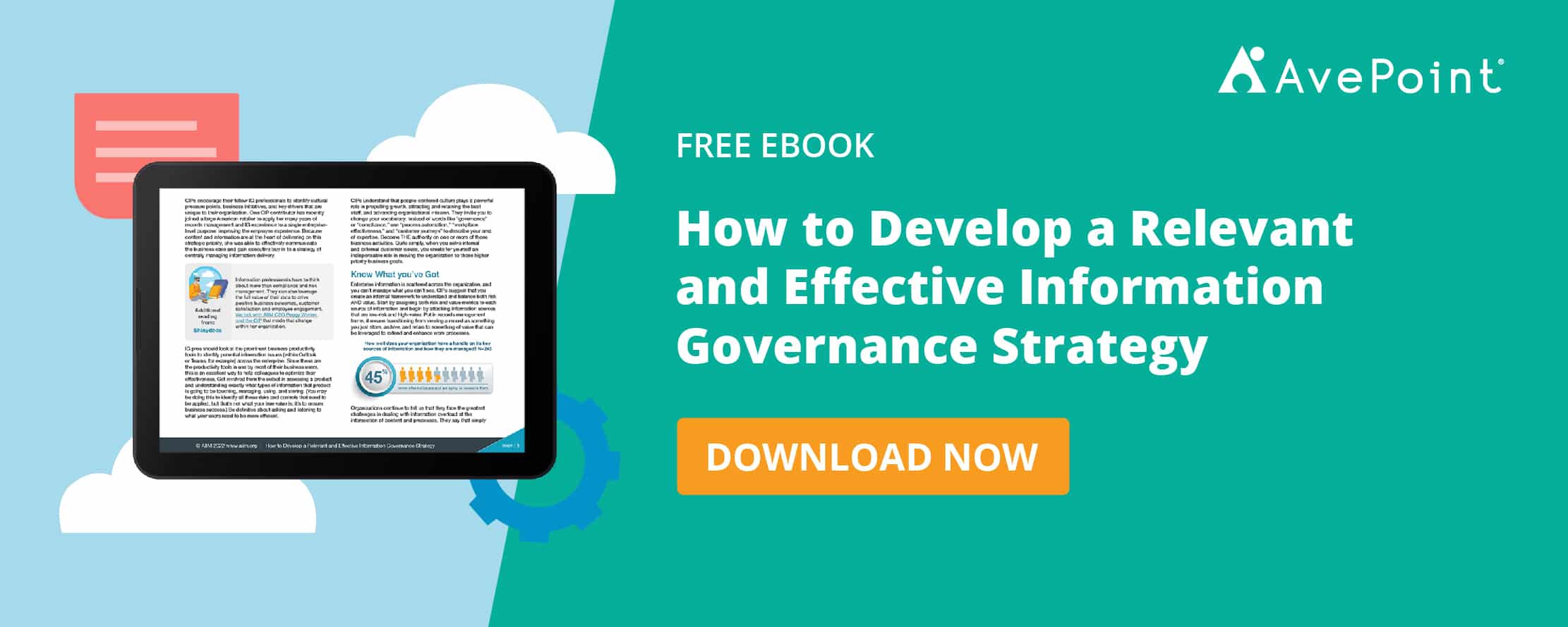Facing stricter compliance and regulatory requirements, as well as a growing amount of digital data, many organizations are rethinking – or building from the ground up – their information management systems.
Bendigo Kangan Institute (BKI), a training provider in Victoria, Australia, found itself facing this dilemma a year ago. To meet standards set by the Public Records Office of Victoria (PROV), they needed to establish a centralized and compliant information management system. Unfortunately, their previous methodology was ad hoc and unmanaged, so they were starting from scratch.
While their implementation is still ongoing, they have come a long way in the past 12 months. Learn from their experience how to get started building your own compliant information management strategy.
Where should you start when building a records management strategy?
For any organizational change to be successful, buy-in from the proper stakeholders is a must. The same is true for implementing a new information management process, which is why your end users are the best place to start.
Kerri Ricketts, BKI’s Manager, Records, Information, and Capability says: “Putting a system in place is the easy part. The people challenge is the hardest challenge. Stakeholder engagement early and often is essential. Before we began building our system, we held workshops to ask questions like ‘Where do you want these records to live? What security do you need them to have?’ We then gave users opportunities to continue to engage throughout the process.”
People are often protective of their files and documents and want to hold on to their legacy systems. Most users won’t change or follow new rules if they think they are just ticking a box without understanding why it’s there. By explaining why the change is necessary and continuing to engage users throughout the process, your users are more likely to feel part of the change.
Can you build proper information management in SharePoint?
“SharePoint is great for end users, but a little scary for record managers,” Kerri says. Yet SharePoint can play an integral role in building a records management system as it’s often already in an organization’s repertoire. This was why BKI decided to use SharePoint as their foundation, as the Institute was in the process of consolidating the number of systems they had. In fact, BKI’s vision is for SharePoint to one day be their “single source of truth” for managing records.
To ensure compliance within the application, BKI used AvePoint Cloud Records to implement necessary information management best practices on their SharePoint records. Cloud Records offers advanced records and information management, enabling records managers to easily automate business rules to manage the entire content lifecycle – from creation to classification and retention. The solution can centralize content from Microsoft 365, SharePoint on-premises, Exchange Online, social media, and file systems directly alongside physical records.
Using Cloud Records, BKI set business classifications in the back end, automatically implementing retention periods based on the rules they set for each, and came up with procedures for proper record destruction, ensuring no information would be kept longer than necessary.
They also applied the new standards to previously created Teams workspaces. When they initially rolled out Teams during the pandemic, there was limited governance and training, and most users didn’t know how to properly manage records in the application; they were simply creating Teams to store information. BKI was able to roll back these Teams workspaces, capture the data and records in them in Cloud Records, and create new SharePoint sites – with necessary governance and compliance – to replace them.
How do I know who the right record management partner is for me?
There are many vendors who can help you begin to build your information management system. Many will offer out-of-the-box products that you can implement and begin to use immediately. However, BKI knew this one-size-fits-all sort of product wouldn’t work for them.
First, they were worried if the vendor that hosted this product went out of business, the system would become redundant, and they would need to start over. This is another reason they decided to use SharePoint as their base – they were simply adding functionality to a product they were already using.
Second, they were looking to implement a records management system, not a product. Because they were starting from scratch, they knew it would be a lot of upfront work to begin their implementation, from forming their business classification scheme to creating appropriate business rules. They needed a partner who could listen, understand where they were, and help them build from there.
This was a big reason BKI decided to partner with AvePoint. Kerri explains, “AvePoint’s knowledge of record management and SharePoint was reassuring. While I could’ve Googled my technical questions, the responses I got from AvePoint were knowledgeable and nuanced. They reviewed our classification and rolled it up into something usable, which we based our business rules on.”
Then, BKI used Cloud Records to execute compliant management practices, from naming conventions and audit trails to retention policies and legal destruction of records. Best of all, Kerri can automate many of her manual tasks, which frees her up to have more conversations about how to improve information management and how she can best serve her users.
No matter where you are at in establishing your information management – whether you’re ready for the bells and whistles or you want to pace your implementation, like BKI – it’s important to understand where you are and what your organization is ready for. As Kerri says, “You can’t put the cart before the horse.”
Final advice for people just getting started?
As an organization with siloed information and a strict budget, BKI had to decide the biggest bang for its buck while still getting the compliance it needed. They determined this could be achieved by migrating their most recent records from network shares to SharePoint and working with a partner who could meet them where they currently were, not where they hoped to someday be.
BKI was able to determine exactly where they were by beginning their information management journey with a self-assessment of the current state. With this information, they built foundational record management documentation and training so that the entire organization knew their stance on record management.
Then, and only then, could they begin the rest of the process, building out their one-year, two-year, and five-year plans. These plans are their roadmaps, detailing what the system will be able to do each step of the way and with what budget.
While BKI still has a ways to go to reach its vision of a single, compliant system to manage its records, they’ve come a long way from 12 months ago, and they’re excited to continue to implement new processes to optimize their information management strategy.
Read more about BKI’s experience building its information management strategy with AvePoint.
 Kerri Ricketts is an experienced and qualified professional with over 15 years’ experience and a Masters in Information Management. Having worked across multiple sectors including education, local and state government Kerri has a comprehensive understanding of information management compliance and legislative requirements and experience in developing and implementing compliant and robust records management programs, including creation and implementation of Business Classification Schemes (BC), Naming Conventions, Retention Schedules, Disposal, staff training and records management Policies, Procedures and Strategies, as well as identifying and mitigating risks. Kerri is passionate about embedding best practice seamlessly into everyday processes to enhance efficiencies and effectiveness.
Kerri Ricketts is an experienced and qualified professional with over 15 years’ experience and a Masters in Information Management. Having worked across multiple sectors including education, local and state government Kerri has a comprehensive understanding of information management compliance and legislative requirements and experience in developing and implementing compliant and robust records management programs, including creation and implementation of Business Classification Schemes (BC), Naming Conventions, Retention Schedules, Disposal, staff training and records management Policies, Procedures and Strategies, as well as identifying and mitigating risks. Kerri is passionate about embedding best practice seamlessly into everyday processes to enhance efficiencies and effectiveness.


